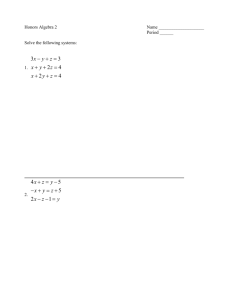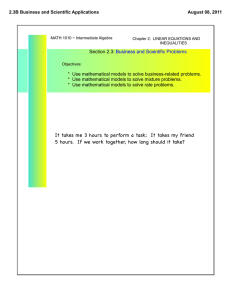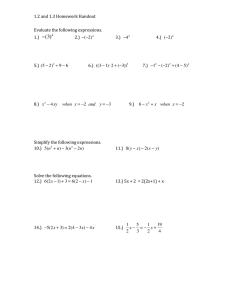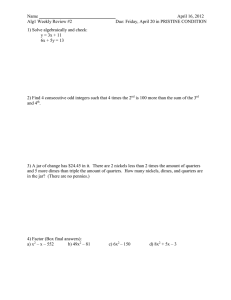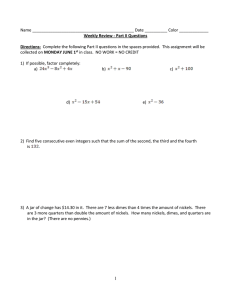Value Mixture Problems: Systems of Equations Worksheet
advertisement
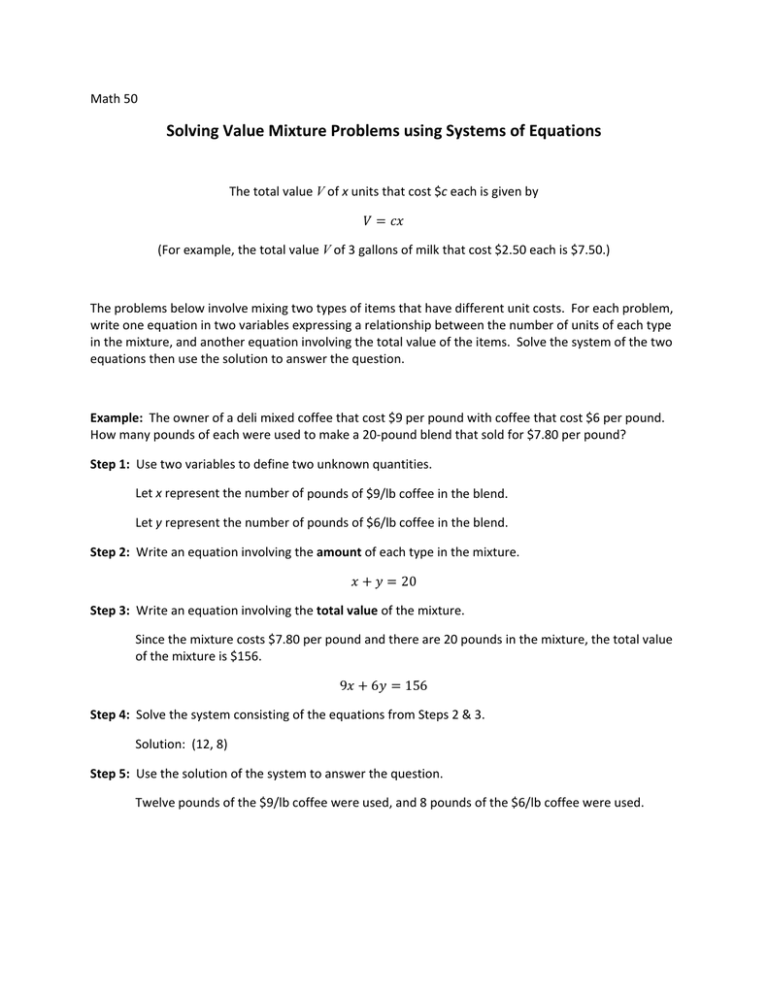
Math 50 Solving Value Mixture Problems using Systems of Equations The total value V of x units that cost $c each is given by (For example, the total value V of 3 gallons of milk that cost $2.50 each is $7.50.) The problems below involve mixing two types of items that have different unit costs. For each problem, write one equation in two variables expressing a relationship between the number of units of each type in the mixture, and another equation involving the total value of the items. Solve the system of the two equations then use the solution to answer the question. Example: The owner of a deli mixed coffee that cost $9 per pound with coffee that cost $6 per pound. How many pounds of each were used to make a 20‐pound blend that sold for $7.80 per pound? Step 1: Use two variables to define two unknown quantities. Let x represent the number of pounds of $9/lb coffee in the blend. Let y represent the number of pounds of $6/lb coffee in the blend. Step 2: Write an equation involving the amount of each type in the mixture. 20 Step 3: Write an equation involving the total value of the mixture. Since the mixture costs $7.80 per pound and there are 20 pounds in the mixture, the total value of the mixture is $156. 9 6 156 Step 4: Solve the system consisting of the equations from Steps 2 & 3. Solution: (12, 8) Step 5: Use the solution of the system to answer the question. Twelve pounds of the $9/lb coffee were used, and 8 pounds of the $6/lb coffee were used. Example: A grocer combined peanuts that cost $5.20/kg with cashews that cost $6.40/kg. How many kilograms of each were used to make a 45‐kilogram mixture costing $6/kg? Step 1: Use two variables to define two unknown quantities. Let x represent the number of kilograms of peanuts in the blend. Let y represent the number of kilograms of cashews in the blend. Step 2: Write an equation involving the amount of each type in the mixture. 45 Step 3: Write an equation involving the total value of the mixture. Since the mixture costs $6 per kilogram and there are 45 kilograms in the mixture, the total value of the mixture is $270. 5.20 6.40 270 Step 4: Solve the system consisting of the equations from Steps 2 & 3. Solution: (15,30) Step 5: Use the solution of the system to answer the question. Fifteen kilograms of peanuts and 30 kg of cashews were used in the mixture. Do these in class: A trail mix is made by combining raisins that cost $4.20 per pound with granola that costs $2.20 per pound. How many pounds of each should be used to make 40 lb of trail mix that costs $2.75 per pound? The total value of the dimes and quarters in a bank is $6.05. There are six more quarters than dimes. Find the number of each type of coin in the bank. Homework: 1. A goldsmith combined an alloy that costs $4.30 per ounce with an alloy that costs $1.80 per ounce. How many ounces of each were used to make a mixture of 200 oz costing $2.50 per ounce? 2. The manager of a specialty food store combined almonds that cost $4.50 per pound with walnuts that costs $2.50 per pound. How many pounds of each were used to make a 100‐pound mixture that costs $3.24 per pound? 3. A bank contains 27 coins in dimes and quarters. The coins have a total value of $4.95. Find the number of dimes and quarters in the bank. 4. A business executive bought 40 stamps for $14.40. The purchase included 39¢ stamps and 24¢ stamps. How many of each type of stamp were bought? 5. A drawer contains 29¢ stamps and 3¢ stamps. The number of 29¢ stamps is four less than three times the number of 3¢ stamps. The total value of all the stamps is $1.54. How many 29¢ stamps are in the drawer? Problems Involving Two Mixtures The problems below involve two separate collections, each consisting of two types of items that have different unit costs. For each problem, write one equation involving the total value of the first collection and another equation involving the total value of the second collection. Solve the system of the two equations then use the solution to answer the question. Example: The manager of a discount clothing store received two shipments of fall clothing. The cost of the first shipment, which contained 10 identical sweaters and 20 identical jackets, was $800. The second shipment, at the same prices, contained 5 of the same sweaters and 15 of the same jackets. The cost of the second shipment was $550. Find the cost of one sweater, and of one jacket. Step 1: Use two variables to define two unknown quantities. Let x represent the cost of one sweater. Let y represent the cost of one jacket. Step 2: Write an equation involving the total value of the first collection. 10 20 800 Step 3: Write an equation involving the total value of the second collection. 5 15 550 Step 4: Solve the system consisting of the equations from Steps 2 & 3. Solution: (20,30) Step 5: Use the solution of the system to answer the question. Each sweater costs $20 and each jacket costs $30. Do these in class: For the first performance of a play in a community theater, 50 reserved‐seat tickets and 80 general‐ admission tickets were sold. The total receipts were $1700. For the second performance, 80 reserved‐ seat tickets and 120 general‐admission tickets were sold. The total receipts were $2640. Find the price of a reserved‐seat ticket and the price of a general‐admission ticket. Two coin banks contain only nickels and dimes. The total value of the coins in the first bank is $3. In the second bank, there are 4 more nickels than in the first bank and one‐half as many dimes. The total value of the coins in the second bank is $2. Find the number of nickels and the number of dimes in the first bank. Homework: 1. The manager of a computer software store received two shipments of software. The cost of the first shipment, which contained 12 identical word processing programs and 10 identical spreadsheet programs, was $6190. The second shipment, at the same prices, contained 5 copies of the word processing program and 8 copies of the spreadsheet program. The cost of the second shipment was $3825. Find the cost for one copy of the word processing program. 2. A baker purchased 12 lb of wheat flour and 15 lb of rye flour for a total cost of $18.30. A second purchase, at the same prices, included 15 lb of wheat flour and 10 lb of rye flour. The cost of the second purchase was $16.75. Find the cost per pound of the wheat and rye flours. 3. Two coin banks contain only nickels and quarters. The total value of the coins in the first bank is $2.90. In the second bank, there are two more quarters than in the first bank and twice as many nickels. The total value of the coins in the second bank is $3.80. Find the number of nickels and the number of quarters in the first bank.
